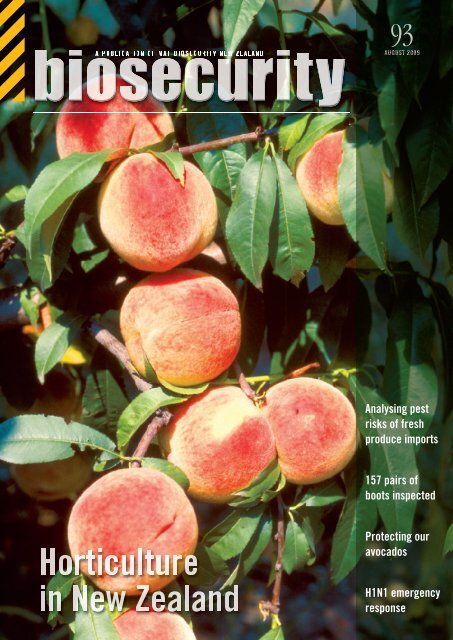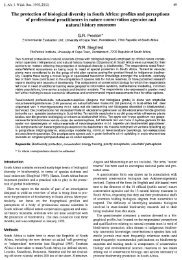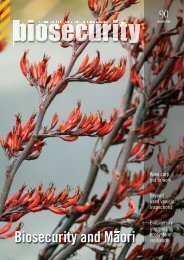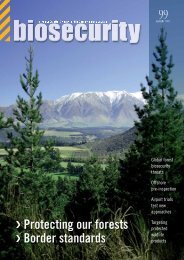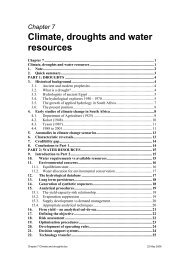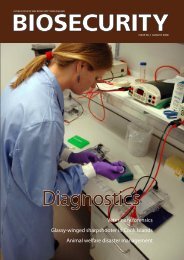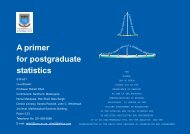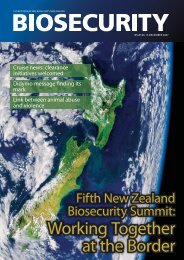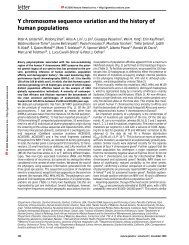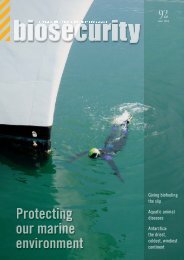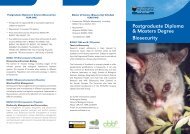AVOCADOS - Biosecurity New Zealand
AVOCADOS - Biosecurity New Zealand
AVOCADOS - Biosecurity New Zealand
Create successful ePaper yourself
Turn your PDF publications into a flip-book with our unique Google optimized e-Paper software.
AUGUGUST200009Analysing pestrisks of freshproduce imports157 pairs ofboots inspectedProtecting ouravocadosH1N1 emergencyresponse
93<strong>Biosecurity</strong> magazine<strong>Biosecurity</strong> is published six times per yearby MAF <strong>Biosecurity</strong> <strong>New</strong> <strong>Zealand</strong>. It is ofspecial interest to all those with a stake inthe protection of <strong>New</strong> <strong>Zealand</strong>’s economic,environmental and social assets from thedangers posed by pests and diseases.Animal welfare issues are also covered. Thearticles in this magazine do not necessarilyreflect government policy.For enquiries about specific articles, referto the contact listed at the end of eacharticle.General enquiries (e.g. circulation requestsor information aboutMAF <strong>Biosecurity</strong> <strong>New</strong> <strong>Zealand</strong>):<strong>Biosecurity</strong> MagazineMAF <strong>Biosecurity</strong> <strong>New</strong> <strong>Zealand</strong>PO Box 2526Pastoral House, 25 The Terrace,Wellington, <strong>New</strong> <strong>Zealand</strong>Phone: 0800 00 83 33Email: biosecurity@maf.govt.nzInternet: www.biosecurity.govt.nzEditorial enquiries:Phone: 04 894 0774ISSN 1174 – 4618Production and printing management byCity Print Communications in associationwith Context Public PolicyCommunications.10 16 20CONTENTSEditorial 3Analysing pest risks of fresh produce imports 4Facilitating horticultural plant imports 6Fruit fly surveillance programme review 8157 pairs of boots inspected! 10<strong>Biosecurity</strong> inspectors go to the circus 11Imports and exports – two sides of the same coin 12<strong>New</strong> <strong>Zealand</strong> to host international seed meeting 12North American Plant Protection Organization Phyto Ecert workshop 13People in biosecurity 13IPPC Commission on Phytosanitary Measures 14Protecting our avocados 16Avocados: young but in strong growth phase 18Pest surveillance – lures and protocols 19H1N1 emergency response work at NCBID – Wallaceville 20Importing equine germplasm 21Egg smuggler convicted 21Import risk analysis on white rhinoceros 22Directory 22Environmental Paper Profile<strong>Biosecurity</strong> Magazine is printed on Sumo Gloss.Sumo is an environmentally responsible papermanufactured under the environmentalmanagement system ISO 14001 using ElementalChlorine Free (ECF) pulp sourced fromsustainable, well managed forests.
93Wayne HartleyEDITORIALHorticulture in <strong>New</strong> <strong>Zealand</strong><strong>New</strong> <strong>Zealand</strong>’s diverse and successful horticultural industry has a longestablished international reputation for supplying high-quality products,and includes some of the nation’s most innovative food producers,processors and exporters.Our environment provides the idealgrowing conditions for a wide varietyof fruit, vegetables, nuts, seeds, nurserystock and flowers that meet not onlythe needs of local consumers, but alsofulfil the stringent quality andbiosecurity requirements of ourinternational markets.Reflecting its location in the southernhemisphere, topography and 15,000kilometres of coastline, <strong>New</strong> <strong>Zealand</strong>has a temperate maritime climate.With distinct regional climaticcontrasts and a variety of soil types, itis ideally suited for growing a diverserange of horticultural crops. With atotal land area of 26.9 million hectares,over 100,000 hectares is currently usedin commercial production, with majorhorticultural areas located inNorthland, Pukekohe, Waikato, Bay ofPlenty, Gisborne, Hawkes Bay,Horowhenua/Manawatu, Nelson,Canterbury and Otago.The importance of horticulture to <strong>New</strong><strong>Zealand</strong>’s economy cannot be underestimated. The horticultural sectorcomprises approximately 7000commercial growers, and directlyemploys around 50,000 people,generating revenue of NZ$4.2 billionin 2008.As only a small proportion ofproduction is consumed domestically,horticultural producers generally relyon export markets. Accordingly, <strong>New</strong><strong>Zealand</strong> exports products to more than120 countries; with Europe, Australia,Japan and the United States being thebiggest markets for our commodities.The value of these horticultural exports(excluding wine) is approximatelyNZ$2 billion a year, which equates to 8percent of <strong>New</strong> <strong>Zealand</strong>’s totalmerchandise exports.<strong>New</strong> <strong>Zealand</strong> is a trading nation. Theprosperity of our horticultural industrydepends on achieving and maintainingaccess to offshore markets. To protectand enhance our horticulturalproduction base and the contributionit makes to the economy, <strong>New</strong> <strong>Zealand</strong>depends on biosecurity more thanmost other developed countries.<strong>Biosecurity</strong> is essentially aboutunderstanding and managingbiological risks crossing in and out of<strong>New</strong> <strong>Zealand</strong>. We need to export.Equally we need to import. Importsinto <strong>New</strong> <strong>Zealand</strong> could bring inunwanted pests and diseases, while ourexports could present some biosecurityrisks for our trading partners. We needto be sure that the standards we areapplying to products coming into <strong>New</strong><strong>Zealand</strong> are consistent with thestandards that we are prepared to meetfor our products entering othercountries.MAF <strong>Biosecurity</strong> <strong>New</strong> <strong>Zealand</strong>’smission is to enhance <strong>New</strong> <strong>Zealand</strong>’snatural advantage. We do this byencouraging high-performing sectors,developing safe and freer trade,ensuring healthy <strong>New</strong> <strong>Zealand</strong>ers andby protecting our natural resources forthe benefit of future generations.■Wayne Hartley, Manager, Fresh Produce (Imports),Plant Imports and Exports Group, Border StandardsDirectorate, MAFBNZMAF BIOSECURITY NEW ZEALAND 3
93 HORTICULTUREAnalysingpest risks offresh produce imports<strong>New</strong> <strong>Zealand</strong>ers are used to having variety in produce all year round thanks toa broad range of imported fresh produce, cut fl owers and foliage – but withimports come the risk of organisms that could harm ourenvironment and economy.In 2008, nearly 170,000 tonnes offresh produce and about15 million stems of cut flowersarrived at the border. Most of theseimports are “out of season” or tropicalfruits, vegetables, flowers and foliage.As a trading nation, <strong>New</strong> <strong>Zealand</strong>depends on imports and exports. Inorder to benefit all partners, tradeneeds to be safe. Therefore, under the<strong>Biosecurity</strong> Act 1993, Import HealthStandards (IHSs) based on riskanalyses are prepared for all freshproduce imports into <strong>New</strong> <strong>Zealand</strong>.<strong>New</strong> <strong>Zealand</strong> is also a member of theWorld Trade Organization (WTO) anda signatory to the WTO Sanitary-Phytosanitary (SPS) Agreement. Underthese international obligations, riskanalysis is used to determine what kindof intervention might be justified tomanage the risk of pests and diseasesthat any import may present.In the <strong>New</strong> <strong>Zealand</strong> biosecuritycontext, “risk” means an organismentering, establishing and causingharm to the natural environment,agriculture and/or horticulture, andtherefore the economy.The range of organisms that can beassociated with fresh produce is vast,such as microscopic viruses andbacteria within or on plant tissue,fungi, and multitudes of insects, mites,spiders, snails and nematodes.When considering a new import, thefirst stage is to define the scope of theproposal. For example, <strong>New</strong> <strong>Zealand</strong>imports citrus from several countries,each of which may have a differentclimate, level of development, postharvestinfrastructure and pestorganisms. Thus organisms likely to beassociated with that variety or speciesfrom that particular locality areconsidered.A list of organisms potentiallyassociated with the proposed import isdeveloped from scientific literature,interception records and informationEudocima fullonia (fruit piercing moth).Photo courtesy www.ento.csiro.auprovided by the exporting country.This preliminary hazard list can belarge, but not all those species will beassociated with the actual commodity.To begin refining the preliminary list,questions are addressed, such as, is it in<strong>New</strong> <strong>Zealand</strong>? Are there straindifferences? Can it be a vector fordisease not here? What plant part is itassociated with?For example, the red wax scale isrecorded on citrus, but it infests theleaves, not the fruit. Even though thisscale insect may be included in thepreliminary list, since it is not recordedon fruit it is not considered beyondthis point.The next step is to further refine thelist by considering whether theorganisms can enter, reach a suitable4 MAF BIOSECURITY NEW ZEALAND
HORTICULTURE93In the <strong>New</strong> <strong>Zealand</strong> biosecurity context risk means anorganism entering, establishing and causing harm to thenatural environment, agriculture and/or horticulture, andtherefore the economy.habitat, establish and cause harm. Thisuses understanding of the ecology andbehaviour of the organism, such as therange of hosts it can attack, its lifestages, method and rate ofreproduction, length of time it takes togo through its life cycle, the number ofgenerations produced in a year,developmental temperature thresholds,overwintering ability and more.An example from the risk analysisFresh Citrus Fruit from Samoa isEudocima fullonia, a fruit-piercingmoth. The large, robust adults causedamage to ripening citrus and manyother fruits by their nocturnal feeding.They shelter in dense foliage duringthe day when fruit would be harvestedand are likely to move away fromdisturbance. The eggs, larvae andThe caterpillar of the fruit piercing moth Eudocima fullonia.Photo by Melanie <strong>New</strong>field, MAFBNZ.pupae are associated withnon-citrus host plants, soit is considered unlikelyfor any life stage of thismoth species to enter withcitrus fruit.On the other hand, themelon thrips, Thripspalmi, is considered apotential hazard on citrusfruit. This is becausemelon thrips larvae andadults are small (less than1 mm long), are highlymobile, can feed on thefruit and shelter under thecalyx. This pest can breed rapidly, feedsin groups causing severe injury to thehost plants, and is difficult to controlbecause it is resistant to manyinsecticides. Should it enter andestablish, it would have serious impactson the horticultural industry and couldimpact on <strong>New</strong> <strong>Zealand</strong>’s exports tocountries that do not have this species.The next step is to assess theeffectiveness of a range of mitigationmeasures. Under the SPS Agreement,the rationale for the measures must bescientifically justified and applied onlyto the extent necessary.There is often a degree of uncertaintyin risk analysis. This is because there isnot always information available on theorganism or aspects of the organismbeing assessed, and it is important tostate the critical areas of uncertaintythat might alter the conclusions if newinformation became available.The draft risk analysis considers thelikelihood and consequences of entryand/or establishment of hazardorganisms and provides options formanaging the risks. It is peer reviewedby experts, such as specialists ininsects, fungi and viruses, and thensubmitted for public consultation. Thisgives the exporting country, importers,producers and members of the publicwho are interested the opportunity tocomment on the science associatedwith the risk and the options formanaging it.When submissions from publicconsultation have been reviewed andincorporated, the draft risk analysis isready to be made “final” and will beused in the drafting of Import HealthStandards.For information about the Fresh CitrusFruit from Samoa risk analysis, seeCitrus RA link: www.biosecurity.govt.nz/files/regs/imports/risk/citrussamoa-ra.pdf;on risk analysisprocedures: www.biosecurity.govt.nz/regs/imports/ihs/risk and on balancein trade: www.maf.govt.nz■Deb Anthony, Adviser, Risk Analysis –Plants, Policy and Risk Directorate, MAFBNZ,deb.anthony@maf.govt.nzMAF BIOSECURITY NEW ZEALAND 5
93HORTICULTUREFACILITATING HORTICULTURAL PLANT IMPORTSThe horticultural industry is dependent on introduced plants. Continued access tonew germplasm is crucial to enable the sector to remain globally competitive, forexample, by introducing improved traits such as disease resistance and to developnew varieties that customers desire.All plants imported into <strong>New</strong> <strong>Zealand</strong> must meetcertain requirements to ensure that damaging pestsand diseases are not inadvertently imported. Someof these pests and diseases could cause significant damage ifthey became established, for example, plum pox disease instonefruit.The import requirements for plants are determined by MAF<strong>Biosecurity</strong> <strong>New</strong> <strong>Zealand</strong> (MAFBNZ) and includeinspection, testing or treatment – overseas, at the <strong>New</strong><strong>Zealand</strong> border and/or in post-entry quarantine.Depending on the importance of the crop and the severity ofassociated pests and diseases, imported seed and plants maybe released at the border – for example, seed of mostornamental plants – or following quarantine. Unless sourcedfrom MAFBNZ-approved high-health schemes, manyimportant crops – such as apple and pear budwood, hoprhizomes and strawberry plants – must be imported into themost contained level of quarantine (Level 3).Until recently, all Level 3 quarantine services (provision ofglasshouse space and laboratory testing) were providedprivately. However, private organisations were only able toprovide services for a limited number of crops, such asavocados, grapevines and kiwifruit. Therefore, in 2006, theGovernment provided funding to ensure these services wereavailable for all important horticultural crops. MAFBNZ’sPlant Health and Environment Laboratory (PHEL) has usedthis funding to develop:• testing manuals (describing the materials and methodsused to test for pests and diseases in quarantine); and• quarantine testing and space (on a cost-recovered basis)where these services are not provided by private industry.PHEL has since provided quarantine for several privateimporters. The first plants to be released, in December 2008,were disease-free clones of a commercial kumara variety, andwere the first new germplasm of this crop that has beenimported into <strong>New</strong> <strong>Zealand</strong> in more than 10 years.PHEL is also:• quarantining blackcurrant and strawberry plants, whichagain have not been imported for many years;Strawberry plants in quarantine at PHEL (limited multiplication enables an increase in the number of plants that can be released from quarantine).6 MAF BIOSECURITY NEW ZEALAND
HORTICULTURE93Quarantine for new arrivalsHave you ever wondered what happens to livenursery plants that are grown overseas? Aucklandbased Abu Iqram, <strong>Biosecurity</strong> Officer – Plants,explains MAFBNZ’s role.• collaborating with other suppliers by providing testingfor crops such as apples, blueberry and kiwifruit, whichare being held in private quarantine facilities;• conducting research to enable more cost-effectivetesting, for example, by combining multiple tests intoone method or developing generic tests that detect awide range of pests and diseases, such as for a group ofquarantine viruses;• looking at ways to facilitate the importation of alternativeforms of new germplasm, for example, the laboratory hasdeveloped a new method to directly test imported pollenfor pests and diseases.Further details about PHEL’s activities can be found at:www.biosecurity.govt.nz/pests/plants/phelFurther information about plant import requirements is at:www.biosecurity.govt.nz/regs/imports/plants■■Quarantine enquiries: Virology and Post-entry Quarantine (PEQ) Team, Plant Healthand Environment Laboratory – Investigation and Diagnostic Centres, MAFBNZ,peqtesting@maf.govt.nzImport requirements: Plant Imports Team, Border Standards Directorate, MAFBNZ,plantimports@maf.govt.nzImported plants of tissue-cultured kumara prior to growth and inspection in PHEL’squarantine glasshouse.MAFBNZ’s Abu Iqram inspects quarantined plants.On arrival in <strong>New</strong> <strong>Zealand</strong>, plants are inspected at the border by MAF<strong>Biosecurity</strong> <strong>New</strong> <strong>Zealand</strong> (MAFBNZ). In Auckland, this usually happens at theInternational Mail Centre, air cargo or express freight companies. <strong>Biosecurity</strong>inspectors ensure the plants are disease and insect free and that paperworksuch as Import Permits and Phytosanitary Certificates are in order. Thepaperwork is then forwarded to a biosecurity officer and the plants areforwarded to a post-entry quarantine (PEQ) transitional facility.About four weeks later, a biosecurity officer visits the PEQ facility andundertakes the first post-entry quarantine inspection. The objective of postentryquarantine is to exclude regulated organisms from <strong>New</strong> <strong>Zealand</strong> byisolating imported plants.Plants are then regularly inspected and tests undertaken to detect thepresence of any regulated organisms. Inspections are generally carried outover a period of up to 16 months after arrival in <strong>New</strong> <strong>Zealand</strong>, depending onthe type of plant.When any suspected pests or symptoms are discovered during an inspectiona sample is taken for identification by an approved laboratory.If the sample confirms the presence of a regulated organism (an organismnot present in <strong>New</strong> <strong>Zealand</strong> or under official control), it is necessary to eithertreat the plants, reship or destroy them. In most cases the importer choosesthe treatment option, after which, a biosecurity officer re-inspects the plantsto ensure effectiveness of treatment.Results sometimes confirm that the pest or disease is a regulated virus,bacteria or high impact fungi/pest such as Pine Pitch Canker or scale (e.g.,Florida Red Scale). In this situation there is no treatment option availableand the items must be destroyed under MAFBNZ supervision.Depending on the crop and its quarantine period, a series of inspections isundertaken. A six monthly facility audit is also carried out to make sure thatthe quarantine facility complies with PEQ standards. All inspections andpest identifications are paid for by the importer.Over the past year, there have been 500 inspections completed at 45transitional PEQ facilities.For more information about standards for PEQ facilities see www.biosecurity.govt.nz/regs/trans/stds#plants or for requirements for importing plants seewww.biosecurity.govt.nz/regs/imports/plantsMAF BIOSECURITY NEW ZEALAND 7
93 HORTICULTUREFruit fly surveillanceprogramme review<strong>New</strong> <strong>Zealand</strong> has a successful fruit fl y surveillance programme that protects the horticulture industryagainst these harmful pests. MAF <strong>Biosecurity</strong> <strong>New</strong> <strong>Zealand</strong> (MAFBNZ) believes it can be even better, and isplanning to review the surveillance programme over the next year.<strong>New</strong> <strong>Zealand</strong> is fortunate to befree of economicallyimportant species of fruit fly.The fruit fly surveillance programmehas been running since the 1970s, andprovides assurance of <strong>New</strong> <strong>Zealand</strong>’sfreedom from fruit flies. Surveillanceserves a dual purpose – to provideconfidence to our trading partnersthat <strong>New</strong> <strong>Zealand</strong> is fruit fly-free, andto give us an early warning of fruit flyincursions so as to facilitateeradication.The fruit fly surveillance programmeconsists of seasonal monitoring forthe presence of fruit fly through theuse of lure traps placed throughout<strong>New</strong> <strong>Zealand</strong>. It is an effectiveprogramme, and fruit flies have beendetected. However, the programmehas not undergone a thorough reviewsince 1989, and a lot of informationhas been generated since then thathas the potential to improve thetechnical and operationalmanagement of the programme.MAFBNZ is planning to do a reviewof the programme in the coming year,involving the horticulture industryand fruit fly experts, both withinMAFBNZ and externally.The overall objectives of the revieware to identify improvements thatcould be made to the effectivenessand efficiency of the programme. Thereview might also be used to identifygaps in information required tooptimise the programme, includingidentifying research that could beundertaken to bridge these gaps.One key area for review is theeffectiveness of the current trappinggrid to ensure the design is alignedtemporally and spatially to the siteswhere fruit flies could establish, andthat it is targeting the most high-riskspecies. MAFBNZ will also aim toreview the current fruit fly trappingprotocols to ensure the programme isusing the most efficient and up-todatemethods.MAFBNZ would also like to developan objective way to measure theeffectiveness of the fruit flyCurrent fruit fly trapping locations.surveillance programme. This wouldhelp to provide confidence in <strong>New</strong><strong>Zealand</strong>’s status as a country free offruit flies, and to measure thecontribution of surveillance activities,compared with pre-border or borderactivities. Once the review iscomplete, MAFBNZ expects such ameasure would provide confidencethat the programme has become moreefficient.8 MAF BIOSECURITY NEW ZEALAND
HORTICULTURE93NETS 2009 –RemarkableChangesWhat are fruit fl ies?Fruit flies belong to the family Tephritidae, which includes more than 4500species, about 20 of which are considered to be serious pests. The <strong>New</strong> <strong>Zealand</strong>fruit fly surveillance programme targets economically important species such asthe Queensland fruit fly, Oriental fruit fly and Mediterranean fruit fly. These pestsinfest a wide variety of fruits and vegetables, including citrus, apples, feijoa,avocados and many others.Fruit flies damage fruits and vegetables when the female fly lays eggs inside theskin of the fruit. The larvae then develop and grow inside the fruit, leaving thefruit pulp damaged. Most countries harbour some species of fruit flies, but <strong>New</strong><strong>Zealand</strong> is fortunate to be free of these pests. Fruit flies could enter the countryvia imported fruit and vegetables, or through passengers arriving in <strong>New</strong> <strong>Zealand</strong>from overseas, and carrying fruit with them.How does the fruit fly surveillance programme work?About 7500 traps are set up and maintained from September to June of eachyear. Traps are placed in grids, concentrated in populated areas serving ascentres for tourism or trade, areas of significant horticultural activity and areasthat are climatically suitable for fruit flies to establish.Traps are placed in the canopy of a fruit tree at each site. MAFBNZ-approvedtrappers check each trap for fruit flies every two weeks during the trappingperiod. Traps used in the programme are Lynfield traps, which are baited with alure plug to attract the flies.Three different types of lure are used: Cuelure, Trimedlure or Methyl Eugenol –each of which attracts a different type of fruit fly. A dichlorvos (DDVP) insecticidestrip is also placed in the bottom of each trap to ensure the captured flies arekilled and retained in the traps until the next inspection.This programme is only one part of a series of measures put into place byMAFBNZ to manage of the risk of fruit fly entry into <strong>New</strong> <strong>Zealand</strong>. At the border,x-ray and sniffer dogs help to detect unauthorised fresh produce. There are alsovarious Import Health Standards in place to ensure imported fresh produce isfree of viable fruit fly and their eggs.This year’s <strong>New</strong> <strong>Zealand</strong><strong>Biosecurity</strong> Institute conference(NETS) will be held in Queenstown14–16 October at the Rydges Hotel.The conference theme – “RemarkableChanges” – recognises both Queenstown’sremarkable location and the remarkablechanges that have taken place in pestmanagement and biosecurity over thepast 30 years. The conference will alsoexplore some of the changes we may seein biosecurity in the coming years.If you intend to be involved in biosecurityin the future, you should be in Queenstownfor NETS 2009.Highlights include speakers such as JohnHellstrom – one of <strong>New</strong> <strong>Zealand</strong>’s forwardthinkers in biosecurity, and ProfessorPhillip Hume from the Bio-Protection andEcology Division at Lincoln University.There will also be the opportunity to learnabout biosecurity issues from those at thecoal face of pest management.The landscape of Central Otago has alsoseen remarkable changes over time –some not necessarily for the better. Thescheduled field trips for NETS 2009 willshowcase this amazing part of the countryand the pressures it has had to contendwith – from both pests and people.To register for NETS 2009 go to the<strong>New</strong> <strong>Zealand</strong> <strong>Biosecurity</strong> Institute’swebsite at www.biosecurity.org.nzMAF BIOSECURITY NEW ZEALAND 9
93 HORTICULTURE157 pairs of boots inspected!MAF <strong>Biosecurity</strong> <strong>New</strong> <strong>Zealand</strong> (MAFBNZ) works closely with the<strong>New</strong> <strong>Zealand</strong> Defence Force when soldiers return home from Timor-Leste.Asixth contingent of <strong>New</strong><strong>Zealand</strong> troops returnedhome from Dili, Timor-Leste,in mid-June having spent six monthspatrolling the streets on peacekeepingduties. Each rotation of peacekeepers isassisted in their pack-up by MAFBNZbiosecurity inspectors and <strong>New</strong><strong>Zealand</strong> Customs Service officers.The inspectors travelled to Dili andchecked military equipment andpersonal belongings for a total of 157personnel prior to the packing andreturn home to <strong>New</strong> <strong>Zealand</strong>. Thiskeeps the biosecurity risk offshore andfacilitates a speedy process for thetroops on arrival at Ohakea Airbase,Bulls.The risks associated with equipmentand personal effects from Timor-Lesteare significant, especially in regard toweed seeds.During the “extraction of Task GroupGyro 6”, MAFBNZ seizures included:• Two suspected Siam weedChromolaena odorata seeds werefound and destroyed. Siam weedis one of the world’s most invasivetropical weeds. If it arrivedin Northland, it could invadeagricultural and horticultural land,poison stock and smother nativeforests.• A therapeutic pillow stuffed withgreasy goat hair and contaminatedwith what appeared to be acaciatree seeds.• Two planks of timber – beingbrought home for carving – wererejected because of long hornborer damage. Importation waspermitted when clean replacementplanks were found.Immediately prior to boarding theaircraft home, a boot inspectionMAFBNZ Quarantine Inspector Nick Hale, Wellington, inspects military equipment being packed in Dili for return home.Boot sole with spiny seeds embedded.detected 38 pairs contaminated withspiny seeds embedded in the soles. Itwas important to remove every lastseed, not only to keep <strong>New</strong> <strong>Zealand</strong>safe but also Australia because theaircraft was flying via Darwin.MAFBNZ biosecurity inspectors wereagain impressed by the high standardof cleanliness achieved by defencepersonnel in preparing for theirjourney home. The biosecuritymessage is clearly understood at alllevels in our defence force. Troops takepride in ensuring that they complywith our requirements, and thuscontribute to <strong>New</strong> <strong>Zealand</strong>’s futurehealth status.■Jaimie D Baird, <strong>Biosecurity</strong> Inspector, Nelson,MAFBNZ, jaimie.baird@maf.govt.nz10 MAF BIOSECURITY NEW ZEALAND
HORTICULTURE93<strong>Biosecurity</strong> inspectors go tothe circusPre-inspection of Cirque du Soleil circus equipment is an example of thevalue in keeping biosecurity risks offshore.MAF <strong>Biosecurity</strong> <strong>New</strong><strong>Zealand</strong> (MAFBNZ)biosecurity inspectorsrecently travelled to Melbourne, at therequest of Time Frame Logistics (NZ)Ltd, to pre-inspect the Cirque du Soleilcircus equipment prior to it beingpacked up and shipped to <strong>New</strong><strong>Zealand</strong> for its “Dralion” show.On arrival at the Melbourne Docklandssite, MAFBNZ biosecurity inspectorsBrent Kleiss, Emma Jackson and KimThornton met the staff in charge andbegan their work with a guided tour ofthe layout.They then inspected and clearedpersonal effects for 140 people andcarried out interior inspections ofcontainers that had been cleaned readyfor packing.All goods and equipment wereinspected before loading into 70containers. Most containers also hadpest bombs added to them beforebeing bolt-sealed and placed on a flatrack stand on tarmac for exteriorcleaning to remove soil and spiders.The importance of external checks onthe containers became clear whenseveral redback and whitetail spiderswere found.The Cirque staff had learned from theprevious pre-clearance to <strong>New</strong> <strong>Zealand</strong>to ensure popcorn machines, mastsand seats were thoroughly cleanedbefore inspection. The staff wereco-operative and cleaned to anextremely high standard.Cirque staff were also interested in thepre-inspection and understood thepotential effects on our <strong>New</strong> <strong>Zealand</strong>environment of any unwantedorganisms.The value of pre-inspecting such cargomeans MAFBNZ can keep thebiosecurity risk offshore and allow foreasier clearance at the <strong>New</strong> <strong>Zealand</strong>border, with the containers beingshipped directly to Cirque du Soleil’ssite.MAFBNZ’s thanks go to MarkSelwood, Time Frame Logistics (NZ)Ltd; Claudio Vella and his crew atMAFBNZ <strong>Biosecurity</strong> Inspector Brent Kleiss checks theinside of a container.Cleaning the circus tent and containers.Cirque du Soleil; and Matt Taylor,Optim Cargo Services, for theirassistance during this pre-inspection.■Sue Gould, Team Manager Offshore, MAFBNZ,sue.gould@maf.govt.nzThe Cirque du Soleil show Dralion has been touring theworld since April 1999, and features 65 artists from 14countries. It was scheduled to run in Auckland from 10 Julyto 23 August.MAF BIOSECURITY NEW ZEALAND 11
93 HORTICULTUREImports and exports– two sides of the same coinMAF <strong>Biosecurity</strong> <strong>New</strong> <strong>Zealand</strong> (MAFBNZ) facilitates international trade (imports and exports) and supports<strong>New</strong> <strong>Zealand</strong>’s horticultural interests while meeting international obligations to the International Plant ProtectionConvention (IPPC) and the Sanitary and Phytosanitary (SPS) Agreement.MAFBNZ works to createnew opportunities, forhorticultural importingand exporting sectors, by assistingwith access to <strong>New</strong> <strong>Zealand</strong> – oroverseas markets – when requested.This is not always an easy task.Gaining access to overseas marketscan take several years, depending onthe priority the importing countrygives the request. The prioritisationprocess can depend on:1. first in first served;2. expected volume of trade; and3. political influence, which mayinclude preferential prioritisationbecause of a free trade agreement.Regardless of prioritisation, theprocess for gaining market accessusually follows the same stepswhether this is for a request for animported plant commodity or a newmarket for a local horticulturalproduct. The market access process isas follows.STEP 1: Initiate request for accesswith an importing country (providetechnical information, which mayinclude pests of a commodity, pestmanagement and productiontechniques, post-harvest treatmentsand climate data). This informationcan be provided at STEP 3.STEP 2: Importing countryprioritises request.STEP 3: Importing country initiatesimport/pest risk assessment.STEP 4: Initiating country receives acopy and outcomes of the riskassessment.STEP 5: Initiating countrycomments on risk assessment andnegotiates pest risk mitigationmeasures where necessary.STEP 6: Importing country grants/declines market access and setsimport regulations, which may includean import permit or specific protocols.Regardless of whether new marketaccess is requested by <strong>New</strong> <strong>Zealand</strong> toanother country, or another countryrequests access to <strong>New</strong> <strong>Zealand</strong>, theprocess is lengthy and requires bothpatience and expert technical analysisfrom the countries involved. This isbecause <strong>New</strong> <strong>Zealand</strong>, and themajority of <strong>New</strong> <strong>Zealand</strong>’s tradingpartners, belong to the IPPC and workto International Standards forPhytosanitary Measures (ISPMs),which involves an equivalent,transparent risk-based assessmentsystem for market access of newcommodities.Importers and exporters are urged tocommunicate with MAFBNZ early onto find out what is required and, if,how and when this can be achieved.■Dr Joanne Wilson, Senior Adviser, MAFBNZ,joanne.wilson@maf.govt.nz<strong>New</strong> <strong>Zealand</strong> to host international seed meetingThe Ministry of Agriculture and Forestry (MAF), in a joint venture with the <strong>New</strong> <strong>Zealand</strong> Seed Quality ManagementAuthority and the <strong>New</strong> <strong>Zealand</strong> Grain and Seed Trade Association, is to host the Organisation for EconomicCo-operation and Development (OECD) annual Seed Schemes meeting in Christchurch in March next year.This is the first time the meetinghas been held in Australasiasince the OECD Scheme wasformed more than 50 years ago.The meeting will confirm theappointment of Peter Johnston, MAF<strong>Biosecurity</strong> <strong>New</strong> <strong>Zealand</strong> SeniorAdviser – Plant Exports, as Chair ofthe annual meeting of the OECDSchemes for the Varietal Certificationof Seed Moving in International Trade.Mr Johnston will be the first <strong>New</strong><strong>Zealand</strong>er to be appointed to thisposition – he has been Chair of theTechnical Working Group on VarietalIdentification and Varietal Purity forthe past two years.<strong>New</strong> <strong>Zealand</strong> joined the Grass andLegumes and Crucifer Schemes in1966 and has been a regular and activeparticipant over the past 15 years.“Seed is one of the key cornerstones toour primary industries’ success. <strong>New</strong><strong>Zealand</strong> seed breeders and growers arecontinually developing and producinghigh quality seed to service nationaland international food productionsystems,” Mr Johnston says.“Hosting the 2010 annual meeting inChristchurch offers an opportunity forus to showcase <strong>New</strong> <strong>Zealand</strong>’ssuccessful seed industry to over 57international delegations who will bevisiting this country.”■Peter Johnston, Senior Adviser – Plant Exports,MAFBNZ, peter.johnston@maf.govt.nz12 MAF BIOSECURITY NEW ZEALAND
North American Plant ProtectionOrganization Phyto Ecert workshopHORTICULTURE93<strong>New</strong> <strong>Zealand</strong>’s reputation as a world leader in developing electronic export certifi cation systems led to twoMAF <strong>Biosecurity</strong> <strong>New</strong> <strong>Zealand</strong> (MAFBNZ) staff members attending and presenting two papers at an ElectronicPhytosanitary Certifi cation workshop in Canada in May.<strong>New</strong> <strong>Zealand</strong> has operated anelectronic export certificationsystem since the <strong>New</strong> <strong>Zealand</strong>Food Safety Authority (NZFSA)introduced this approach in 1998.MAFBNZ adopted the system, knownas Phyto Ecert, in 2001, for the exportof plant and forestry products.Various improvements have been madeto Phyto Ecert since its introductionand more are planned to furthersafeguard against forgery, reduce therisk of non-compliant product beingexported overseas and to better facilitatethe provision of official assurances.Karen Sparrow, MAFBNZ Manager– Plant Exports, and Peter Johnston,MAFBNZ Senior Adviser – PlantExports, along with Nicola Championfrom Topaz (the IT service providerfor Phyto Ecert), were invited to theElectronic Phytosanitary Certification(Phyto Ecert) workshop in Ottawaby the North American PlantProtection Organization (NAPPO).The workshop was attended bydelegates from 15 countries and threeassociated international organisations– the World Customs Organization,United Nations Centre for TradeFacilitation and the InternationalPlant Protection Convention (IPPC).<strong>New</strong> <strong>Zealand</strong> gave two of the 15formal presentations at the workshop– “<strong>New</strong> <strong>Zealand</strong> Ecert Experiencesto date” and “Phyto Ecert XMLData Map” under the theme of“Towards Paperless Certification”.Mr Johnston said the key objective ofthe workshop in Ottawa was to get abetter understanding of the electroniccertification activities undertakenin different countries and regions.“The workshop also establisheda collaborative forum for thestandardisation of electronic certificationand a framework for electronic messageexchange between National PlantProtection Organisations (NPPOs)”.In 2008, MAFBNZ was involvedin an IPPC working group torevise International Standards forPhytosanitary Measures (ISPMs) 7 and12. These standards are concerned withexport certification systems and theprovision of phytosanitary certificates.Mrs Sparrow said participation in theIPPC working group and NAPPOworkshop provided MAFBNZ withan opportunity for significant inputinto the standardisation of electroniccertification and certificate dataexchange at an international level.“MAF also has the opportunity to leadby being a key participant in electroniccertification messaging trials,” she said.The NAPPO workshop identifiedseveral challenges including gainingagreement on a standard format andframework for certificate data exchange,as well as getting commitment fromIPPC member countries to worktowards an internationally acceptedelectronic certification system.“The work that MAF, NZFSA andTopaz have completed to date with Ecertdevelopment has laid the groundwork forinternational discussions,” Mrs Sparrowsaid. “As a small country we are fortunateto be active participants in an areathat has the capability of standardisinginternational official assurances.The long term and downstreamadvantages of this standardisation willstreamline import/export pathways.”The workshop presentations areavailable on the NAPPO website:www.nappo.org/menu_e.shtml■ Peter Johnston, Senior Adviser, MAFBNZ,peter.johnston@maf.govt.nzEsther Richardson has joined MAF<strong>Biosecurity</strong> <strong>New</strong> <strong>Zealand</strong> (MAFBNZ) as anincursion investigator with the IncursionInvestigation Plants and Environment teamat the Tamaki Investigation and DiagnosticCentre (IDC). She has a Masters of VeterinaryStudies degree in epidemiology from MasseyUniversity. Her thesis was on assessing therisk of Trichinella spiralis in exported porkmeat from <strong>New</strong> <strong>Zealand</strong>. Esther has recentlyreturned to <strong>New</strong> <strong>Zealand</strong> after three years working in Ireland for theAgriculture and Food Development Authority, where she implemented acollaborative project with the Centre of Veterinary Epidemiology and RiskAssessment investigating the spread and impact of Johne’s disease (achronic wasting disease) in Irish cattle. Prior to starting with MAFBNZ,Esther was involved with setting up a University of Auckland projectassessing noise-induced hearing loss in different occupational groups.Her areas of experience and interest are quantitative risk assessment,statistical and spatial analyses.Erin Green has joined MAFBNZ as a Policy Analyst in the Policyand Risk Directorate, and will be working primarily on borderpolicy issues. Erin has a Master of Science degree in zoologyand marine science from the University of Otago. She previouslyworked for the Department of Labour, supporting migrants andrefugees settling in <strong>New</strong> <strong>Zealand</strong>. Prior to that, she was withthe Department of Conservation, where she helped establishthe Fiordland Marine Area (Te Moana o Atawhenua) andimplement the associated marine management measures.Rob Gregory has joined the MAFBNZ Policy and RiskDirectorate as a Senior Policy Analyst with primaryresponsibility for animal welfare matters. He has worked inindustry-related animal welfare positions for the past six years.Prior to arriving in <strong>New</strong> <strong>Zealand</strong>, Rob completed a doctorate inanimal welfare and behaviour at Oxford University.PEOPLE IN BIOSECURITYMAF BIOSECURITY NEW ZEALAND 13
93 HORTICULTUREIPPC COMMISSIONON PHYTOSANITARYMEASURESA recent Commission on Phytosanitary Measures (CPM) meetingconsidered a range of important issues, but the Commission needs tofi nd the funds to work effectively, writes MAF <strong>Biosecurity</strong> <strong>New</strong> <strong>Zealand</strong>(MAFBNZ) Policy and Risk Directorate Principal Adviser, InternationalCo-ordination, Dr John Hedley, who represented <strong>New</strong> <strong>Zealand</strong> at themeeting in Rome.The FAO building from the Circo Massimo, Rome.The CPM – and its contractingparties to the InternationalPlant Protection Convention(IPPC) – adopt standards, approve theCommission’s work programme, dealwith administrative matters andgenerally update each other on anysignificant phytosanitarydevelopments.The latest meeting saw discussion on arange of important issues – woodpackaging material, phytosanitarycertification procedures, nationalphytosanitary capacity building andthe international movement of grain.However, the prime issue was how theCommission could find the funds todo its work effectively. This problemmust be solved. Again and again, thesolution of voluntary assessedcontribution has been put forward –and rejected. If other organisations canmanage with this system, perhaps it istime for the IPPC parties to give itfurther consideration?While this year’s proceedings wereinfluenced by the lack of resources forthe Secretariat and work programme,the lack of a full-time secretary and anexcess of administrative issues on theagenda, the meeting ran smoothly anddealt with all the agenda items –mainly owing to the efforts of the newCommission Chair, Reinouw Bast-Tjeerde, from Canada.There were four draft InternationalStandards for Phytosanitary Measures(ISPMs) presented for adoption at theCPM meeting:• ISPM No. 5 – Glossary ofphytosanitary terms (amendments);• ISPM No. 5 – Glossary ofphytosanitary terms (addition ofappendix 1: Terminology of theConvention on Biological Diversityin relation to the glossary ofphytosanitary terms);• ISPM No. 15 – Regulation of woodpackaging material in internationaltrade (revision); and• ISPM No. 32 – Categorisation ofcommodities according to theirpest risk.Each of these items was discussed andsubsequently amended to resolvecomments submitted prior to themeeting or on the floor at the plenarysession.The revision of ISPM No. 15(Regulation of wood packagingmaterial in international trade(revision)) was important because itprovided further guidelines onrepaired and remanufactured woodpackaging material (WPM). RepairedWPM is described as having had up toabout one third of its componentsreplaced and remanufactured WPM ashaving had more than about one thirdof its components replaced.Remanufactured WPM must haveprevious application of the marksremoved and be retreated.The revision also describes acceptablevariants in the mark and states that allWPM has to be made of debarkedwood (apart from a prescribedtolerance). The standard on thecategorisation of commodities isdesigned to facilitate market access ofprocessed products and tries to stopthe use of phytosanitary certificates forprocessed plant products that are of nophytosanitary risk.A point of interest to many countrieswas the meaning of “public officers”– as found in Article V, Phytosanitarycertification, of the IPPC – who issuephytosanitary certificates. Thisdiscussion, initiated by one country,suggested that the issuing authority inanother country was not a governmentagency but a private company. TheIPPC Secretariat produced a paper, theUnited Nations Food and AgricultureOrganization (FAO) legal office made a14 MAF BIOSECURITY NEW ZEALAND
HORTICULTURE93The importance of building national phytosanitary capacity,particularly in developing countries, has been recognised ascritical to the success of the IPPC.CPM delegates break during the 4th session in the FAO plenary hall.pronouncement and many countriesstated their views. Finally, the CPMagreed that the term “public officer”was sufficiently well defined in ArticleV of the IPPC, ISPM No. 7 and 12 andno further interpretation was required.It was also stated because ISPM No. 12was under review that no changesshould be made to this standard inregard to public officers.The CPM also received a report fromthe Open-ended Working Group onbuilding national phytosanitarycapacity. The importance of buildingnational phytosanitary capacity,particularly in developing countries,has been recognised as critical to thesuccess of the IPPC. Although therewas some disagreement, a conceptpaper and draft strategy wereprovisionally approved to allow thedevelopment of an operational planthat will be presented to the next CPMmeeting. This whole process mightseem a little slow, but it is essential thatCPM members agree on what shouldbe done and that they undertake aneffective plan for the future.The CPM spent some time discussinghow many standards could be dealtwith over the next CPM year. TheSecretariat proposed that it shouldsubmit a maximum of the equivalent offive draft standards for consultationrather than have the StandardsCommittee decide how manystandards should be considered. It wasagreed that the Standards Committeeshould take into account theSecretariat’s capacity when proposingthe number of standards forconsideration.Several options to reduce CPMactivities, or scale of activities, so as tolessen expenditure were alsoconsidered. After much discussion andno decisions, the matter was left to theBureau to consider at its June meeting.Further items on the agenda noted thatno countries had made offers to fund anyof the IPPC’s Trust Fund projects. Fewcountries have contributed to the TrustFund, despite it being made clear at eachmeeting that the FAO will not becontributing any more funds to the IPPCbudget. It was pointed out by a CPMmember that if 100 countries contributedjust US$10,000 each, the Trust Fundwould have a million dollars.The CPM had a short scientific sessionthat looked at pest movement throughfood aid shipments. These talks will befollowed up by an open-ended workinggroup that will discuss the production ofa standard regarding the internationalmovement of grain.■Dr John Hedley, Principal Adviser, InternationalCo-ordination, Policy and Risk Directorate, MAFBNZ,john.hedley@maf.govt.nzMAF BIOSECURITY NEW ZEALAND 15
93 HORTICULTUREPROTECTINGOUR <strong>AVOCADOS</strong>MAF <strong>Biosecurity</strong> <strong>New</strong> <strong>Zealand</strong> recently declared <strong>New</strong> <strong>Zealand</strong> free ofAvocado Sunblotch Viroid – a disease that threatens our avocadoproduction and export markets. This successful outcome was achievedthrough extensive collaboration between the Avocado Industry Counciland MAF <strong>Biosecurity</strong> <strong>New</strong> <strong>Zealand</strong> (MAFBNZ).Avocado Sunblotch Viroid(ASBVd) was believed to bepresent in <strong>New</strong> <strong>Zealand</strong> as aresult of testing undertaken by theMinistry of Agriculture and Forestry(MAF) during a subtropical cropsurvey in 1999.However, the disease has never beendetected since, despite extensiveindependent surveys and testingcarried out by the Avocado IndustryCouncil (AIC). This raised uncertaintyabout the previous detection and led tothe formation of a joint MAFBNZ–industry working group in 2005 thatwas tasked with designing surveillanceand testing protocols based oninternationally recognised standardsand best practice.The overarching objective of thisproject was to determine the status ofASBVd within <strong>New</strong> <strong>Zealand</strong> and toprovide MAFBNZ with the assuranceand confidence for any reassessment ofcountry status. The aim was to developa programme for preserving access tooverseas markets. This is of greatimportance to the avocado industry,which exports a high percentage of itscrop to Australia valued at between$20–35 million a year.The working group comprisedtechnical advisers and scientists fromwithin MAFBNZ and industry,drawing together the necessary skillsand expertise from both parties. Thegroup developed a new MAFBNZsurveillance standard for the detectionof ASBVd and was responsible for theco-ordination of MAFBNZ-approvedservice providers. MAFBNZ was alsoresponsible for auditing the serviceproviders for compliance to thestandard and for the validation of testresults.In February 2009, the AIC contractedthese service providers to carry out asurvey of avocado sites to meet thesampling and testing protocolswithin the MAFBNZ standard. InJune 2009, the survey wascompleted. The field samplingand mapping component wasdelivered by AsureQualityLimited, which utilisedsample bar coding/scanningand GPS readings to individually16 MAF BIOSECURITY NEW ZEALAND
HORTICULTURE93“The collaborative approachprovided an opportunity forachieving the best outcomefor everyone concerned.”identify sample trees and enable ease oftraceability. Samples were tested byLinnaeus laboratory using state-of-theart,real-time polymerase chainreaction (PCR) technology. ASBVd wasnot detected, and, as a result,MAFBNZ has since declared <strong>New</strong><strong>Zealand</strong> free of ASBVd.AIC Chief Executive Alan Thorn saysthat, from the AIC’s perspective, thejoint working group has beeninstrumental in contributing to thesuccess of this project.“There was a wide representation fromwithin MAF <strong>Biosecurity</strong> <strong>New</strong> <strong>Zealand</strong>,including surveillance, borderstandards, Plant Health andEnvironment Laboratory (PHEL) andcompliance and enforcementpersonnel. This gave our industry agood understanding of the concernsand requirements from the collectiveMAF <strong>Biosecurity</strong> <strong>New</strong> <strong>Zealand</strong>viewpoint.”Katherine Clift, Surveillance Manager,Post Border, MAFBNZ said thecollaborative approach provided anopportunity for achieving the bestoutcome for everyone concerned.“It enabled us to work through theproblems together, ensuring the needsof both parties were met, withoutcompromising the overall integrity ofthe result.”Another major factor contributing tothe success of the project was theexpertise of the late Dr Rod Bonfiglioli,technical director of RiversunNurseries Limited and its subsidiaryLinnaeus. His knowledge of ASBVddetection methodologies was a crucialfactor in providing the level ofassurance that MAFBNZ was seeking.The project has been a bigcommitment for both parties.MAFBNZ provided a large amount ofexpertise and staff resources, and therehas been heavy investment by the AIC.Both parties are pleased with thecollaborative approach and theoutcome, and would encourage otherindustries to consider collaborativeapproaches to their own biosecurityprojects.AvocadoSunblotchViroidASBVd is a viroid that is readily transmitted viagraft transmission during propagation or frominfected seedlings.Avocado trees affected with ASBVd may beeither symptomatic (express physical symptomsof the disease), or asymptomatic and exhibit nosymptoms of the viroid but still be capable ofinfecting other trees.Symptoms can be seen on trees, twigs, fruit andleaves, and include:• infected trees that are stunted and have asprawling growth habit;• twigs that have a light-yellow, sunken streakthat follows the length of the twig;• fruit that has localised yellow and reddepressed lesions generally extending fromthe stem to the base of the fruit;• leaves that display areas of “bleached”symptoms and are sometimes distorted.Affected trees suffer from reduced yields ofbetween 15–30 percent, and losses are furtheraggravated by down-grading of disfigured fruit.Once trees are infected there is no controlfor the disease and infected trees should beremoved to avoid any further contamination ofother trees.■Karen Pugh, Senior Adviser Plant Response, MAFBNZ,karen.pugh@maf.govt.nz; Vivien Thomson, AdviserSurveillance, MAFBNZ, vivien.thomson@maf.govt.nzMAF BIOSECURITY NEW ZEALAND 17
93HORTICULTURE<strong>AVOCADOS</strong>:young but in strong growth phase<strong>Biosecurity</strong> magazine asked the Avocado Industry Council’s ChiefExecutive Alan Thorn about the industry and its views on biosecurity.What is the importance ofbiosecurity to your industry?The avocado industry is relativelyyoung but is still in a strong growthphase, and as volumes increase, greaterpressure is placed on existing markets.It is imperative that we explore optionsfor new markets while working topreserve access into our existingmarkets.As volumes grow, the importance ofbiosecurity issues steadily increases asnew threats emerge. In the past threeyears, the industry has dealt with twoorganisms that were incorrectlyrecorded as being present in <strong>New</strong><strong>Zealand</strong> [avocado scab, Sphacelomaperseae, and Avocado SunblotchViroid, ASBVd] and, as a result, haveposed a threat to access into our majormarket, Australia. With a new seasoncomes a new issue that we are urgentlytrying to deal with [light brown applemoth, Epiphyas postvittana, into theUnited States].The incidences the industry has facedover the past few years have focusedour thinking on just how importantbiosecurity is to the future of theindustry, and it is clear that we mustplan for the unexpected.What are the biosecuritychallenges?One of the main issues for avocadogrowers is that the centre of productionis based in the Bay of Plenty, whichalso has a strong tourism industry.There is tension between betterservicing the tourism industry throughinfrastructure, such as an internationalairport located in the region, that mustbe balanced against the biosecuritythreat that is potentially imposed.A significant portion of the industry isbased in the Far North (AupouriPeninsula), which has relatively fewhorticultural crops – apart fromavocados. Given the climate (which iswarm) and prevailing winds, we needto be vigilant of new pests and diseasesaffecting this area.Importation of new germplasm hasbeen a major issue for the industrygiven the lack of suitable quarantinefacilities. We have had a close workingrelationship with Riversun Nurseries,which has seen new cultivars finallybeing released in the past two seasons.How do you manage thesechallenges?Experience has taught us theimportance of maintaining a closeworking relationship with MAF<strong>Biosecurity</strong> <strong>New</strong> <strong>Zealand</strong> (MAFBNZ).One of the benefits of this is the abilityto respond relatively quickly whenrequired.The other key to managing ourbiosecurity challenges is our ability todraw on experts, wherever they mayreside, and seek their input ondeveloping a working solution. With ayoung crop, the avocado industry is ata relative disadvantage in terms of thenumber of researchers who are activelyworking on avocados. The importanceof research and development is also anissue that the industry is mindful of.Our industry has a strong internalcapability, and the skills and experienceof the people working in it areinvaluable.What do you see as the futurebiosecurity issues?Our immediate issue is the light brownapple moth (LBAM) and access intothe United States. The solution theindustry is pursuing – the use ofwaterblasting technology – raises arange of possibilities for the future thatwe will actively explore with MAFBNZ.The industry works closely with itscounterparts in various countries,exchanging information on newcultivars, while being mindful that weneed to preserve access to thegermplasm and minimise risk to theexisting plantings. A key activity in ournext phase of growth will involvekeeping a watching brief of biosecuritydevelopments in other countries andhow these could impact on ourindustry. Wherever possible we willseek to identify and minimise threatsbefore they emerge as a crisis.18 MAF BIOSECURITY NEW ZEALAND
HORTICULTURE93Pestsurveillance –lures and protocolsAvocado IndustryCouncilThe Avocado Industry Council (AIC) is a limitedliability company officially recognised by theGovernment as representing <strong>New</strong> <strong>Zealand</strong>avocados. With that recognition comes therequirement that any exporter who wants toexport avocados needs to be licensed with theHorticultural Export Authority (HEA).The AIC deals with any contractual arrangements necessaryfor the management of the industry. Under the HEA, the AICimplements quality standards, export grade standards and rulesand procedures that must be followed by growers, pack housesand exporters.Industry facts• The industry vision is “Through outstanding leadershipachieve 12 million trays with an industry value of $250 millionby 2015”.• The <strong>New</strong> <strong>Zealand</strong> avocado industry reached a value of close to$50 million in the 2008–09 season, with $31 million gained inexport earnings.• The dominant variety of avocado grown in <strong>New</strong> <strong>Zealand</strong> isHass.• Avocado trees are biennial bearing, meaning productionfluctuates up and down from year to year.• The export season runs from about October to March.• The 2008–09 season saw 91 percent of exported fruit go toAustralia, 7 percent to Japan, and 2 percent to other markets.The 2009–10 season will see a resumption of exports to theUnited States.• The main avocado production areas in <strong>New</strong> <strong>Zealand</strong> are theBay of Plenty (63 percent), followed by Whangarei (20 percent),Northland (5 percent) and the rest of the country (8 percent).• The total number of <strong>New</strong> <strong>Zealand</strong> avocado growers isestimated at 1630, of which about two-thirds are exportgrowers.• Mature plantings (trees of five years and older) exceed 4000hectares.■For more information, see: www.nzavocado.co.nzThe Quadrilateral Scientifi c Collaboration in Plant<strong>Biosecurity</strong> (Quads) pest surveillance project teamhas developed an online database to increaseinformation sharing on surveillance protocols forinsect pests of plants.MAF <strong>Biosecurity</strong> <strong>New</strong> <strong>Zealand</strong> (MAFBNZ) isinvolved in a project on sharing informationabout pest surveillance protocols and lures usedin trapping and surveillance programmes. The project is partof the Quads collaboration, which facilitates scientificco-operation in plant protection between <strong>New</strong> <strong>Zealand</strong>,Australia, the United States and Canada.One aspect of the project is to develop an online database toincrease information sharing on surveillance protocols,including lures and traps. The database will facilitate rapidcross-checking and information retrieval, and is nowavailable on the Quads website www.quadscoop.org. Thedatabase has already proved its value by assisting MAFBNZin identifying sources of lure for the <strong>New</strong> <strong>Zealand</strong> gypsymoth surveillance programme (for details on thisprogramme see www.biosecurity.govt.nz/pests/surv-mgmt/surv/gypsy-moth).All plant pest insect surveillance programmes co-ordinatedby government agencies, or species that are identified as aconcern, are considered to be within the scope of thisdatabase. There are currently more than 400 species ofinsects listed in the database with varying levels ofinformation entered for each species. Key information listedunder each species includes: taxonomic classifications,rationale for the surveillance programme, layout of trappingsites, lures and traps used, cost of programmes, key contactsfor the programme and references/web links for additionalinformation.The database has been lodged on the Quadscoop website asan Excel file under the ‘Resources’ page and will be updatedregularly by the project team. The team welcomes reviewsand additional information on species already listed or newspecies of concern that should be added to the database.■To contact the project team or to apply for access to Quadscoop,email: vivien.thomson@maf.govt.nzMAF BIOSECURITY NEW ZEALAND 19
93NEWSH1N1 emergencyresponse work atNCBID – WallacevilleOn 24 April 2009, the United States and Mexico notifi edthe World Health Organization (WHO) of an outbreak ofa novel influenza AH1N1 virus – now commonly knownas “swine ’flu”. Over the following months, infection bythe novel virus has spread to more than 108 countries,including <strong>New</strong> <strong>Zealand</strong>. On 12 June, WHO declared apandemic.<strong>New</strong> <strong>Zealand</strong> initiated an all-of-government responseto the virus following the discovery of suspectedcases in a party of school children returning homefrom Mexico in late April. By late June, <strong>New</strong> <strong>Zealand</strong> hadconfirmed more than 500 cases.The Ministry of Health (MOH)-led response, together withthe assistance of other government organisations, delayed thevirus establishing in the community for a month. The virusreappeared in sentinel surveillance in mid-June, and MOHannounced on 22 June that <strong>New</strong> <strong>Zealand</strong> was entering themanagement phase.MAF <strong>Biosecurity</strong> <strong>New</strong> <strong>Zealand</strong> (MAFBNZ) was one of thefront-line government agencies involved, through the NationalCentre for <strong>Biosecurity</strong> and Infectious Diseases (NCBID),Wallaceville. The Centre is a collaboration of fourorganisations: MAFBNZ, the Crown research institutesEnvironmental Science and Research (ESR) and AgResearchand the SOE AsureQuality. It includes MAFBNZ’sInvestigation and Diagnostic Centre (IDC) and ESR’s WHONational Influenza Centre. Together, this represents the largestcollection of virologists specialising in diagnostic testing in thecountry, with access to the highest level containmentlaboratory in <strong>New</strong> <strong>Zealand</strong>.One of the purposes of the Centre is to provide a critical massof capability to support emergency responses. In this novelAH1N1 outbreak, the Centre was rapidly called on to supportthe all-of-government response. Samples from travellers toNorth America were arriving at the ESR laboratory within afew days, and MAFBNZ IDC staff were available to supportthis work from the first day of the response.Response testing for suspect novel AH1N1 cases at NCBIDhas been led by ESR, but to develop and support the requiredtest capability, IDC and ESR have pooled resources. Staff fromboth organisations have been working to process samples,achieving a 24-hour turnaround time and throughputs of upWendy Gunn (ESR) and Alecia Quirk (MAFBNZ) processing samples for influenza testing.to 350 samples a day (representing 700 polymerase chainreaction (PCR) tests a day).Samples from the suspect cases first undergo purification ofthe viral genomic RNA. This is then tested using a real-timePCR test to confirm the presence of influenza A andconcurrent PCR testing to detect the novel AH1N1 strain’snucleoprotein gene.Reference testing developed during the response has includedthe sequencing of viral genes to confirm cases. Virus isolation(growing the virus in cell culture) under high-levelcontainment conditions is also being carried out to help withcharacterisation of the virus and monitor it for changes overtime. This includes testing for resistance to osteltamivir(Tamiflu), which has recently been reported from Denmark,Japan and Hong Kong.In addition to dealing with current suspected cases, staff fromboth laboratories have been pooling their knowledge andexperience to develop and implement contingency plans forthe increased workload.IDC staff have extensive experience in the requirements forhigh-through-put testing, and have been able to work with ESRto identify bottlenecks and develop and implement systems tomanage the exceptional sample volumes being experienced.This has included development of test algorithms, provision ofextra equipment, staff training, consumable requirements andbiosafety. As a result of this work, NCBID has been able to copewith the testing of overflow samples from other hospitalvirology laboratories, as they reach their maximum capacity.The novel AH1N1 response has shown that the organisationsworking together at NCBID Wallaceville are able to offermeaningful and practical support across organisations at thefront line of an emergency. This has resulted in an effectivelaboratory system that was able to cope with the changingdemands of this developing health emergency. The improvedoutcomes have validated the concept of the national centre as aflexible and responsive collaboration.■Dr Joseph O’Keefe, Animal Health Laboratory Manager, MAFBNZ,joseph.o’keefe@maf.govt.nz; Dr Sue Huang, Director, National Influenza Centre,ESR, sue.huang@esr.cri.nz20 MAF BIOSECURITY NEW ZEALAND
NEWS93Importing equine germplasmMAF <strong>Biosecurity</strong> <strong>New</strong> <strong>Zealand</strong> (MAFBNZ) is inviting public submissionson a draft import risk analysis on equine germplasm from Australia,Canada, the European Union and the United States.Submissions close 4 September 2009.The risk analysis examines thebiosecurity risks associatedwith the importation offrozen semen and in vivo derivedfrozen embryos of horses, donkeysand zebras (collectively referred to asequine germplasm) from thespecified countries.The methodology used in the riskanalysis follows the standardMAFBNZ risk analysis procedures.Many organisms do not warrant riskmanagement compared with horseimports because they are notassociated with the commodity, or arenot transmitted venereally. Organismsidentified as potential hazards aresubjected to individual riskassessments, which includeconsideration of the likelihood of entry(the disease agent being present at thetime of animal importation), likelihoodof exposure (spread and establishmentif imported) and the likely adverseconsequences if the organism didestablish. For organisms that areconcluded to be hazards in theimported germplasm, options formanaging the risks are presented.The draft import risk analysis, whichwas released on 21 July, is on the MAFwebsite at: www.biosecurity.govt.nz/biosec/consult/draft-ira-equinegermplasm-aust-can-eu-usa■To receive a hard copy of the analysis, contact:Risk Analysis Team Support Officer,MAF <strong>Biosecurity</strong> <strong>New</strong> <strong>Zealand</strong>,Email: risk.analysis@maf.govt.nzPhone: 04 894 0310.Egg smuggler convictedThe Ministry of Agriculture and Forestry (MAF) has welcomed the recent conviction of aLower Hutt man for the illegal importation of chicken eggs.John Jakeman, 62, was convicted forviolating the <strong>Biosecurity</strong> Act 1993. Hewas fined $5,000, sentenced to 200hours community work and ordered topay $250 for court costs.The Wellington District Court heardthat Mr Jakeman had obtained 12 eggsfrom a chicken breeder overseas, andas a self-confessed poultry fancier, hadgone to some trouble to bypass <strong>New</strong><strong>Zealand</strong>’s border biosecurity screeningprogrammes.When interviewed, the defendantadmitted he knew that bringingchicken eggs into <strong>New</strong> <strong>Zealand</strong>without authority was an offence. Hehad suggested the supplier falsify thepackaging description to increase thechance of the eggs entering the countryundetected.MAF Investigations Manager GregReid said the outcome of the case senta clear message about how seriously<strong>New</strong> <strong>Zealand</strong> took biosecurity.“The defendant’s deliberate attempt toimport these eggs and breed from thechickens increased <strong>New</strong> <strong>Zealand</strong>’sexposure to potential disease. It isfrustrating responding to incidentswhere people selfishly put the wellbeingof our country at risk,” Mr Reid said.<strong>New</strong> <strong>Zealand</strong> is free from highlypathogenic Avian Influenza (bird flu),<strong>New</strong>castle Disease and InfectiousBursal Disease, all of which have thepotential to devastate poultry flocksand native bird life.“If we are going to protect thiscountry’s unique biodiversity we mustall be vigilant about preventingunwelcome imports that may carry arisk of introducing a pest or diseaseinto the country,” Mr Reid said.MAF issues import health standards tomanage risks associated with theimport of goods that may causeunwanted harm to natural and physicalresources or human health in <strong>New</strong><strong>Zealand</strong>. These standards set MAF’sprocedures and documentaryrequirements that all importers mustmeet prior to the import and release ofany eggs in <strong>New</strong> <strong>Zealand</strong>.MAF BIOSECURITY NEW ZEALAND 21
93 DIRECTORYImport risk analysis on white rhinocerosMAF <strong>Biosecurity</strong> <strong>New</strong> <strong>Zealand</strong> (MAFBNZ) is invitingsubmissions on a draft import risk analysis on theimportation of white rhinoceros (Ceratotherium simum)from Australia. Submissions close 4 September 2009.This risk analysis has been developed to support thehigh priority Southern White RhinocerosConservation Programme managed by the AustralasianRegional Association of Zoological Parks and Aquaria(ARAZPA). It is a qualitative analysis of the biosecurity risksassociated with the importation of white rhinoceros into <strong>New</strong><strong>Zealand</strong> zoological containment facilities from equivalentfacilities in Australia. The methodology used in the riskanalysis follows the standard MAFBNZ risk analysisprocedures.The draft import risk analysis, released on 21 July, is availableon the MAF website at: www.biosecurity.govt.nz/biosec/consult/draft-ira-rhinoceros-aust■To receive a hard copy of the analysis, contact: Risk Analysis Team Support Officer,MAFBNZ, Email: risk.analysis@maf.govt.nz Phone: 04 894 0310.Pest watch: 23 May 2009 – 3 July 2009<strong>Biosecurity</strong> is about managing risks – protecting the <strong>New</strong> <strong>Zealand</strong> environment and economy from exotic pests and diseases. MAF <strong>Biosecurity</strong> <strong>New</strong> <strong>Zealand</strong> devotes much of itstime to ensuring that new organism records come to its attention, to follow up as appropriate. The tables here list new organisms that have become established, new hosts forexisting pests and extensions to distribution of existing pests. The information was collated between 23 May 2009 – 3 July 2009. The plant information is held in the Plant PestInformation Network (PPIN) database. Wherever possible, common names have been included.ANIMAL KINGDOM RECORDSValidated new to <strong>New</strong> <strong>Zealand</strong> reportsOrganism Host Location Submitted by CommentsCelaenia excavata(bird dropping spider)Significant find reportsNo significant find records during this period.<strong>New</strong> host reportsNo new host records during this period.<strong>New</strong> distribution reportsNo new distribution records during this period.Inanimate host(wall inside house)AucklandIDC (general surveillance)■If you have any enquiries regarding this information please contact NZ<strong>Biosecurity</strong>Surveillance@maf.govt.nzPLANT KINGDOM RECORDSValidated new to <strong>New</strong> <strong>Zealand</strong> reportsOrganism Host Location Submitted by CommentsPotyvirus sweet potato virus G(SPVG)Potyvirus sweet potato virus 2(SPV2)Apscaviroid Grapevine yellow speckle viroid -1(GYSVd-1)Significant find reportsIpomoea batatas(kumara)Ipomoea batatas(kumara)Vitis vinifera(grape)NorthlandNorthlandAucklandIDC (general surveillance)IDC (general surveillance)IDC (general surveillance)Organism Host Location Submitted by CommentsNo significant find records during this period.<strong>New</strong> host reportsOrganism Host Location Submitted by CommentsKalotermes brouni(<strong>New</strong> <strong>Zealand</strong> drywood termite)Acacia floribunda(gossamer wattle)Olearia traversii(akeake)AucklandChatham IslandsScion(high risk site surveillance)Scion(special survey)22 MAF BIOSECURITY NEW ZEALAND
DIRECTORY93Organism Host Location Submitted by CommentsOemona hirta(insect: lemon tree borer)Styphnolobium japonicum(pagoda tree)Hawkes BayScion(high risk site surveillance)Uloma tenebrionoides(insect: dented beetle)Pinus echinata(shortleaf pine)AucklandScion(high risk site surveillance)Parlatoria pittospori(fungus: no common name)Abies grandis(giant fir)WellingtonScion(high risk site surveillance)Leptosphaerulina chartarum(facial eczema fungus)Araucaria heterophylla(Norfolk Island pine)AucklandScion(public enquiry)Heliothrips haemorrhoidalis(insect: greenhouse thrips)Vaccinium corymbosum(highbush blueberry)Hawkes BayScion(high risk site surveillance)Tobravirus tobacco rattle virus(TRV)Tulipa sp.(tulip)NorthlandIDC (general surveillance)Botryosphaeria lutea(fungus: no common name)Acer palmatum(Japanese maple)TaranakiIDC (general surveillance)Discohainesia oenotherae(fungus: no common name)Acer palmatum(Japanese maple)TaranakiIDC (general surveillance)Leucaspis cordylinidis(insect: no common name)Cordyline obtecta(Three Kings cabbage tree)Hawkes BayScion(high risk site surveillance)Parlatoria fulleri(insect: scale)Banksia integrifolia(coastal banksia)AucklandScion(high risk site surveillance)Glomerella acutata(fungus: anthracnose)Schinus molle(pepper tree)AucklandScion(high risk site surveillance)Botryosphaeria parva(fungus: botryosphaeria rot)Schinus molle(pepper tree)Acer sp.(maple)AucklandHawkes BayScion(high risk site surveillance)Scion(high risk site surveillance)Botryosphaeria australis(fungus: no common name)Gleditsia triacanthos(honey locust)GisborneScion(high risk site surveillance)Candidatus Phytoplasma australiense(coprosma lethal decline)Gomphocarpus fruticosus(swan plant)Solanum pseudocapsicum(Jerusalem cherry)AucklandWaikatoIDC (general surveillance)IDC (general surveillance)Platypus apicalis(insect: pinhole borer)Nothofagus dombeyi(southern beech, coigüe)BullerScion (exotic forest survey)Candidatus Liberibacter solanacearum(no common name)Solanum betaceum(tamarillo)Physalis peruviana(Cape gooseberry)AucklandAucklandIDC (liberibacter)IDC (liberibacter)<strong>New</strong> distribution reportsOrganism Host Location Submitted by CommentsScolytus multistriatus(European elm bark beetle)Pheromone trap Gisborne Scion (research survey)Carlavirus Lily symptomless virus(LSV)Tobravirus tobacco rattle virus(TRV)Tulipa sp.(tulip)NorthlandIDC (general surveillance)Discohainesia oenotherae(fungus: no common name)Acer palmatum(Japanese maple)TaranakiIDC (general surveillance)Botryosphaeria australis(fungus: no common name)Gleditsia triacanthos(honey locust)GisborneScion(high risk site surveillance)■If you have any enquiries regarding this information please contact NZ<strong>Biosecurity</strong>Surveillance@maf.govt.nzMAF BIOSECURITY NEW ZEALAND 23
MAF general enquiries: 0800 00 83 33Exotic disease and pest emergency hotline: 0800 80 99 66www.biosecurity.govt.nz


